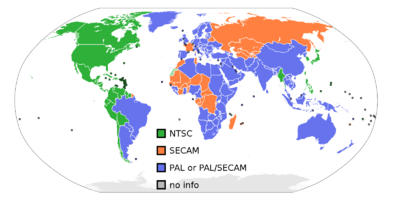NTSC: Difference between revisions
No edit summary |
(Slight pruning. I partially question the cleanup tag, though, considering how we have separate articles and all that.) |
||
| Line 1: | Line 1: | ||
{{ArticleIcons| | {{ArticleIcons|allgames=y}} | ||
{{cleanup|Put info here that is relevant only to NTSC, and expand on this article even more. Check the version differences and add to this article.}} | {{cleanup|Put info here that is relevant only to NTSC, and expand on this article even more. Check the version differences and add to this article.}} | ||
[[File:PAL-NTSC-SECAM.png|thumb|400px|Regions of the world which used the different encoding systems]] | [[File:PAL-NTSC-SECAM.png|thumb|400px|Regions of the world which used the different encoding systems]] | ||
The '''National Television System Committe''' | The '''National Television System Committe''', often referred to as '''NTSC''', was an analog television encoding system used primarily in North America, Japan, and parts of South America. While it has been made obsolete by the use of HDTV and digital component encoding, the term survives as a colloquial reference to the version of games and other televisual media released in the former NTSC regions. . | ||
==Regional differences== | ==Regional differences== | ||
{{main|List of regional version differences (SSBM)|List of regional version differences (SSBB)}} | {{main|List of regional version differences (SSBM)|List of regional version differences (SSBB)}} | ||
Both ''[[Super Smash Bros. Melee]]'' and ''[[Super Smash Bros. Brawl]]'' were released in the NTSC regions of Japan and North America prior to PAL regions; in this "gap" between releases, both games were modified slightly in order to both adjust them for regional reasons, such as changing languages or information relating to release dates, or gameplay fixes, such as fixing [[glitch]]es or changing properties of specific attacks. | |||
== See Also == | == See Also == | ||
* [[PAL]] | * [[PAL]] | ||
* [[Wikipedia:NTSC|Wikipedia's NTSC article]] | * [[Wikipedia:NTSC|Wikipedia's NTSC article]] | ||
[[Category:Game regions]] | [[Category:Game regions]] | ||
Revision as of 12:36, February 16, 2014
The National Television System Committe, often referred to as NTSC, was an analog television encoding system used primarily in North America, Japan, and parts of South America. While it has been made obsolete by the use of HDTV and digital component encoding, the term survives as a colloquial reference to the version of games and other televisual media released in the former NTSC regions. .
Regional differences
Both Super Smash Bros. Melee and Super Smash Bros. Brawl were released in the NTSC regions of Japan and North America prior to PAL regions; in this "gap" between releases, both games were modified slightly in order to both adjust them for regional reasons, such as changing languages or information relating to release dates, or gameplay fixes, such as fixing glitches or changing properties of specific attacks.

